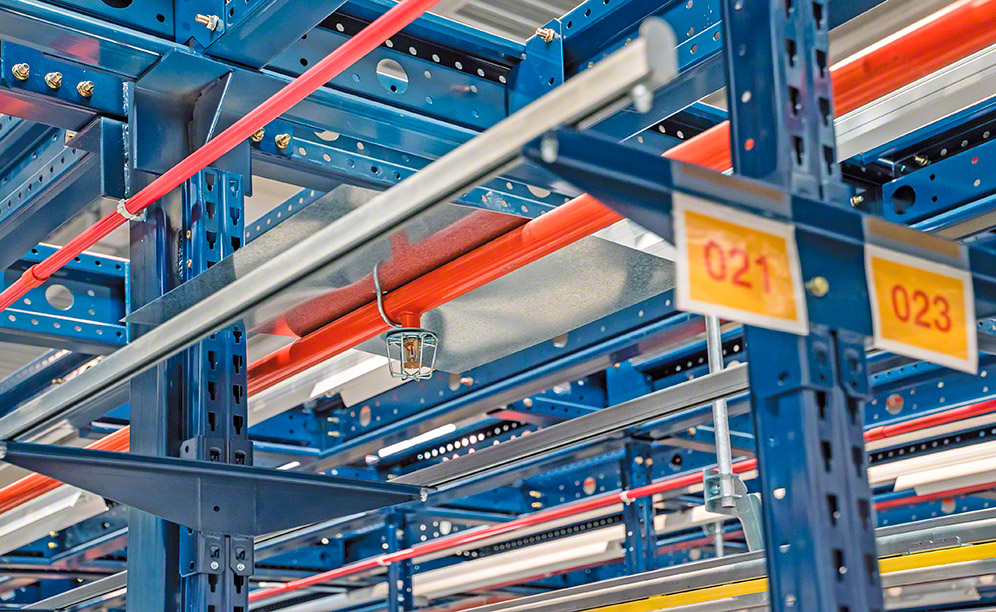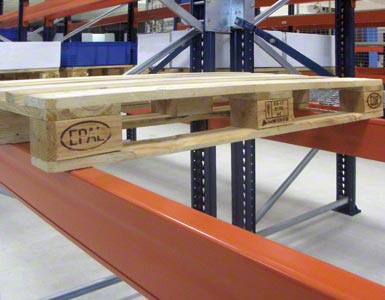Warehouse health and safety is an issue of the utmost importance, since operations carried out in these types of installations involve a high level of risk which must be avoided and prevented at all costs.
Each country, region and city council may have its own fire prevention and health and safety regulations. The planner must keep these in mind and comply with them at all times. This will avoid problems later due to both the eventual situations which could occur, and the administrative and legal consequences arising from any breach of these regulations.
Fire risks
There are many building and safety standards written by experts that comprehensively address fire-related issues, how they start and spread and how they are detected and extinguished. These are very complex issues and they are not covered by this article. Here, it simply aims at providing some general advice to reduce the fire risks and limit the consequences of any incidents.
In modern storage facilities, which have very narrow aisles and consist of structures usually between 10 and 20 metres high (and, in some cases, even exceed 20 metres), extinguishing fires manually can be extremely difficult, if not impossible. Even in warehouses with 4 metres or 5 metres high racking units, it is advisable to install built-in sprinklers, rather than rely solely on equipment mounted in the roof of the warehouse, as is common. Part of the process of designing a warehouse must involve consulting an expert in fire prevention and safety.
Thus, fire safety must be a matter of primary concern when planning an installation. Leaving its design to the end can lead to consequences such as the warehouse being unsafe or the project having to be extensively modified or even halted. For example, the resources used to help personnel evacuate the building if an incident occurs can influence the design of spaces and even the choice of handling devices.
Under normal circumstances, the description of the centre must include detection devices (of flames, colour or smoke) and automated or semi-automated fire extinguishers (of water, foam or gas). It should be remembered that smoke is not only a fire risk; it also endangers the health of the personnel and the condition of materials stored.

Racks with built-in sprinklers
The potential theoretical interference with handling devices may affect the layout of the racking units, their heights, their loads and the shape of the devices. Given that the risks to be taken are the responsibility of the designer, the minimisation of these risks must be one of his or her primary concerns.
Fire prevention system at an installation
In essence, fire prevention consists of minimising the situations that could lead to a fire, i.e. risks.
What can we do to prevent fires?
The storage of flammable or combustible products must be avoided as much as possible. In the event that this cannot be avoided, these materials must be protected against risks arising from the proximity of smokers, faulty wiring, and any ancillary activities normally associated with maintenance teams, such as welding.
It should also be remembered that products stored in a warehouse tend to “perspire”, since they normally have a low combustibility, and wrapped or packaged in cardboard, which ignites easily. Indeed, it is common to find cardboard packages which, for cost reasons, have not been fire-proofed.
Similarly, goods are normally stacked on wooden pallets, which are also likely to burn and, given their mobile nature, are also not fire-proof.

Wooden pallet
These conditioning factors determine the degree of commitment required to adopt the most appropriate criteria in each business. A detailed examination of these factors can provide certain benefits in terms of risk reduction. Cardboard, for example, may be labelled, sealed or wrapped for advertising or distribution purposes using materials that produce a large amount of smoke or toxic gases. In addition, the cardboard itself can be a flammable material when there is a fire. In many cases, this problem can be avoided through the simple use of plastic boxes, even those of lower quality than cardboard boxes, but which offer the same functionality.
Another example of how all pertinent details must be taken into account is the storage of loose metal parts, which, when kept in metal containers, can be a high-risk product due to the possible presence of waste oil at the bottom of the container. As a result, in the design of the operation and the warehouse, there must be a system for inspecting and cleaning these elements before they are introduced into the system.
On the other hand, shrink-wrap plastic used to wrap the pallets makes them more flammable, although its main contribution to the risk of fire relates to the spread of fire, rather than starting it. As a result, a load of cans full of flammable liquid covered in shrink-wrap plastic is better protected against fire than it would be without this wrapping. In the event of a fire the plastic acts as a barrier, reducing the increase in the temperature of the goods and delaying their point of ignition, and therefore the point at which they could start to burn.
In the event of a fire, cardboard packaging acts as a screen against water. Yet when the heat increases, the shrink-wrap plastic becomes dry material for the fire.
Despite taking all these issues into account and complying with the regulations on this topic, a certain level of fire risk is inevitable in a warehouse. Therefore, this must be assumed and the required precautions and measures taken to reduce the damage of such an event, whether caused by the fire, smoke, heat, and even, very frequently, by the water used to put out the fire.
One solution that can be used in large volume warehouses, or in those where high-risk goods must be isolated, is to divide them into compartments using fire-resistant screens.
Another good reason for dividing warehouses into compartments is the existence of a certain proportion of high value goods that could be damaged when putting out a fire with water and which, however, would not be harmed if the fire were to be put out with foam or gas (systems that are suitable in small areas and for certain types of fires and materials).
The use of fire-protection screens can result in the need to install fire doors for vehicles, conveyor belts, personnel, etc. Forklifts with retractable masts may also be required in this case, so that they can go through these doors.
The current trend is to divide up large volume warehouses, which are normally compartmentalised. At times, separate buildings are constructed and connected using automated guided vehicles. Such a system involves a big investment, which must be studied within a company's business strategy for the corresponding operation.
Fire prevention in the racks using sprinklers
Even if the fire risk has been minimised in a warehouse, racking bays can be equipped with an integrated fire detection and extinguishing system. This applies to all racks, both fixed and mobile. For mobile units, there are very well-developed, coordinated systems for supplying water.
Normally, fire hydrants that supply water are located at the top of the building, with the liquid sent to the sprinklers in the racking bays. The number of sprinklers that must be installed and their position on each level of the warehouse will be determined by the risks for that specific installation and what could happen on each level. Sprinklers must be strategically positioned so that they can operate unobstructed.
Often, it will be enough simply to install sprinklers on the ceiling, depending on the height of the building and the fire resistance of the products stored.
In any event, for both the installation of the sprinklers and, in general, everything talked about in this article, it is advisable to seek out health and safety information and services that provide the support, knowledge, and experience of a company that specialises in safety issues, since the characteristics, installations and content of each warehouse can lead to significant changes to the recommendations set out here.
